Comprehensive Report on Management Accounting at ABC Ltd
VerifiedAdded on 2023/01/18
|18
|5050
|41
Report
AI Summary
This report provides a detailed analysis of management accounting practices at ABC Ltd, a medium-sized manufacturing firm. It covers the explanation of management accounting, different types of management accounting systems, and reporting methods used by the company. The report includes a discussion on cost accounting, inventory management, job costing, and price optimization systems, highlighting their benefits and how they are applied within ABC Ltd. Furthermore, it addresses the importance of reliable, up-to-date, and accurate financial information and the need for understandable presentation. The report also touches upon microeconomic techniques such as cost analysis, cost-volume-profit analysis, and flexible budgeting, and their role in management accounting. This document is available on Desklib, a platform providing various study tools and resources for students.
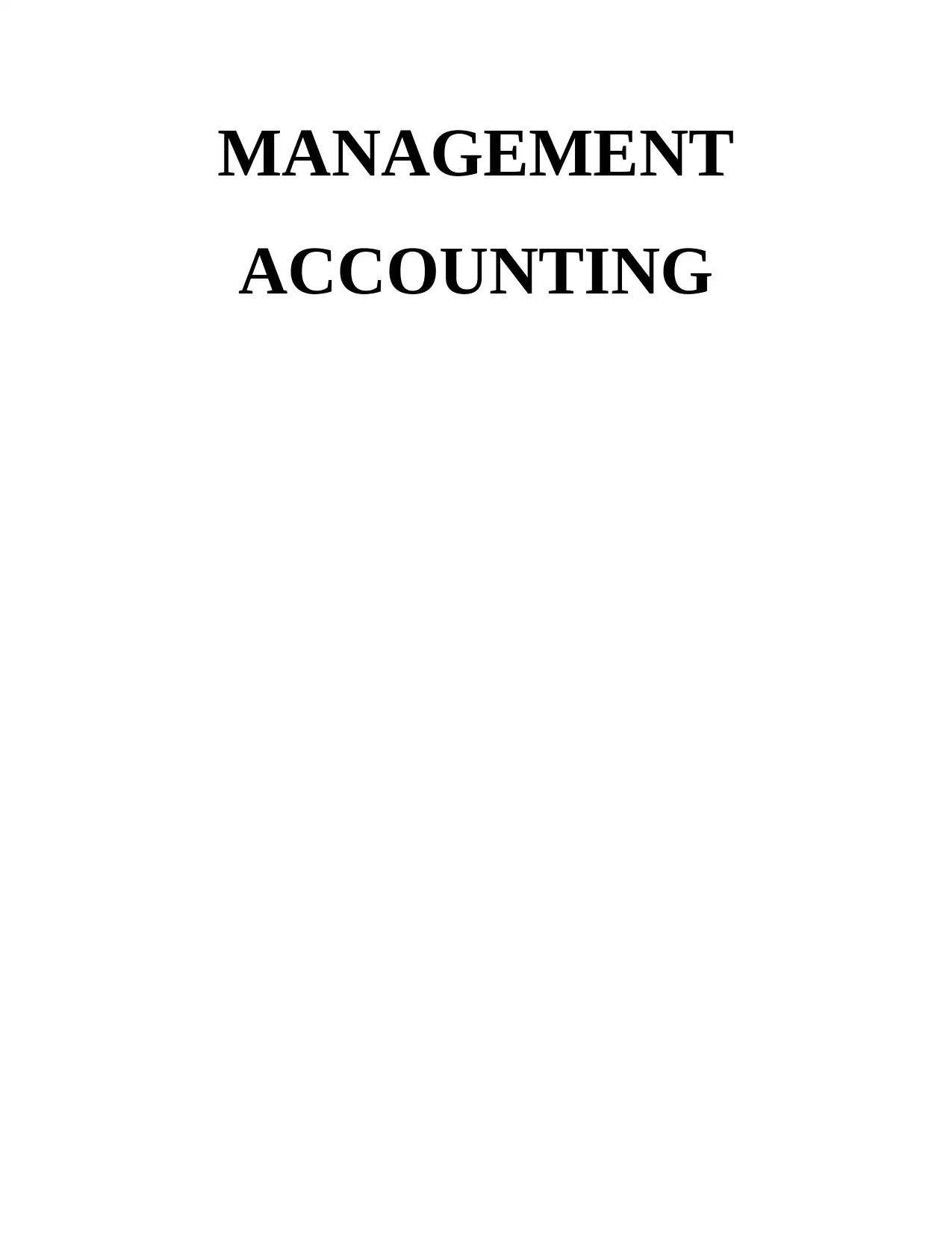
MANAGEMENT
ACCOUNTING
ACCOUNTING
Paraphrase This Document
Need a fresh take? Get an instant paraphrase of this document with our AI Paraphraser
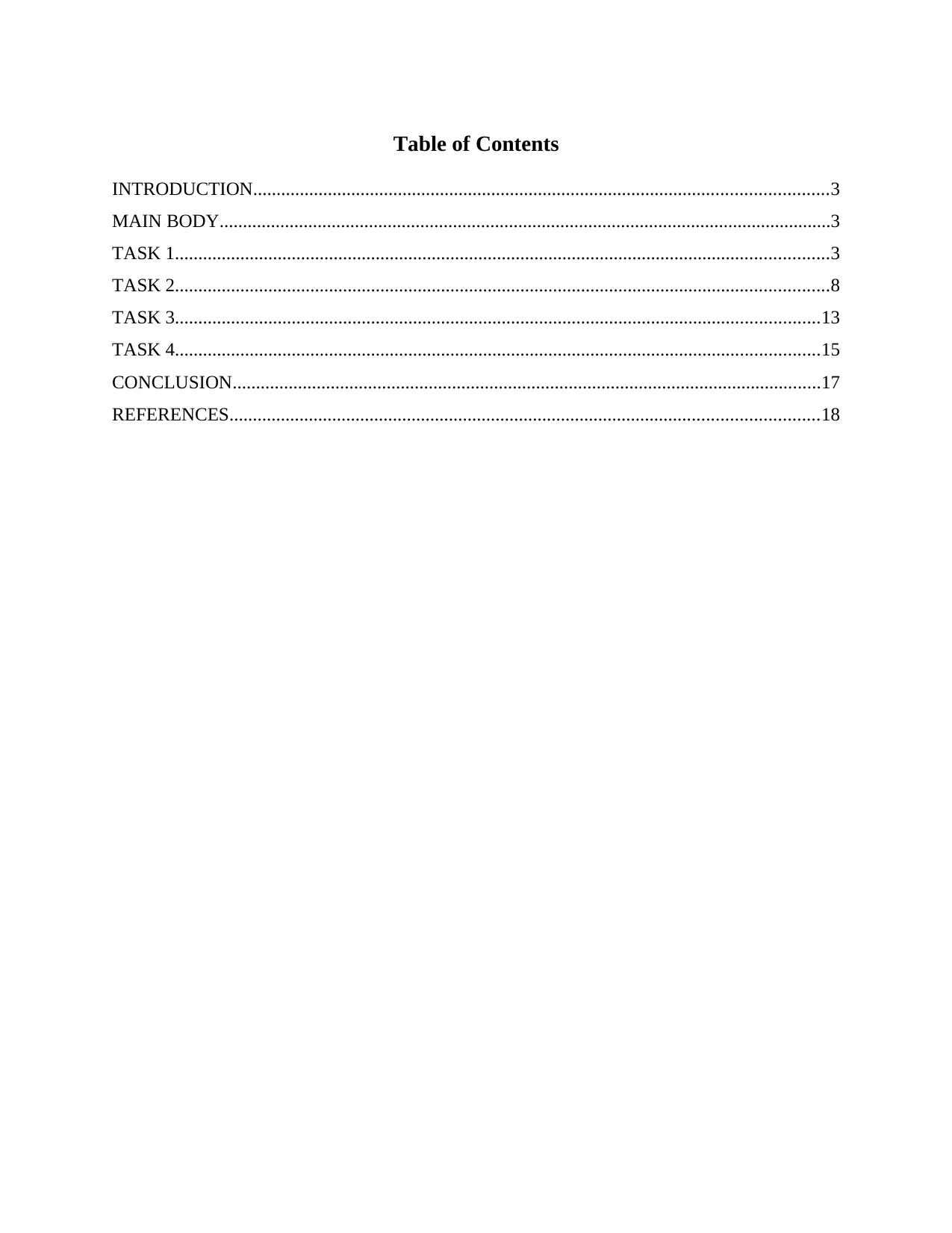
Table of Contents
INTRODUCTION...........................................................................................................................3
MAIN BODY...................................................................................................................................3
TASK 1............................................................................................................................................3
TASK 2............................................................................................................................................8
TASK 3..........................................................................................................................................13
TASK 4..........................................................................................................................................15
CONCLUSION..............................................................................................................................17
REFERENCES..............................................................................................................................18
INTRODUCTION...........................................................................................................................3
MAIN BODY...................................................................................................................................3
TASK 1............................................................................................................................................3
TASK 2............................................................................................................................................8
TASK 3..........................................................................................................................................13
TASK 4..........................................................................................................................................15
CONCLUSION..............................................................................................................................17
REFERENCES..............................................................................................................................18
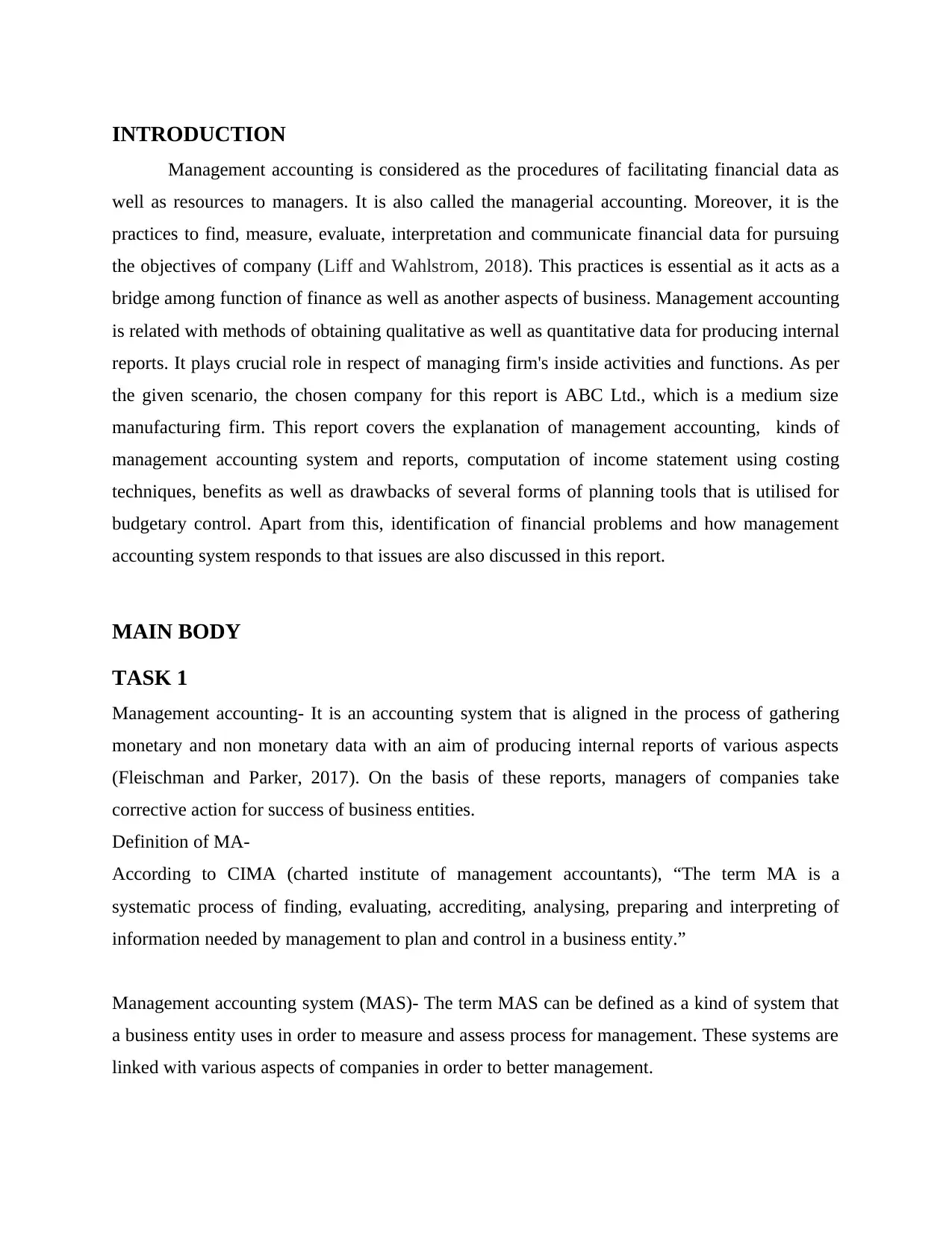
INTRODUCTION
Management accounting is considered as the procedures of facilitating financial data as
well as resources to managers. It is also called the managerial accounting. Moreover, it is the
practices to find, measure, evaluate, interpretation and communicate financial data for pursuing
the objectives of company (Liff and Wahlstrom, 2018). This practices is essential as it acts as a
bridge among function of finance as well as another aspects of business. Management accounting
is related with methods of obtaining qualitative as well as quantitative data for producing internal
reports. It plays crucial role in respect of managing firm's inside activities and functions. As per
the given scenario, the chosen company for this report is ABC Ltd., which is a medium size
manufacturing firm. This report covers the explanation of management accounting, kinds of
management accounting system and reports, computation of income statement using costing
techniques, benefits as well as drawbacks of several forms of planning tools that is utilised for
budgetary control. Apart from this, identification of financial problems and how management
accounting system responds to that issues are also discussed in this report.
MAIN BODY
TASK 1
Management accounting- It is an accounting system that is aligned in the process of gathering
monetary and non monetary data with an aim of producing internal reports of various aspects
(Fleischman and Parker, 2017). On the basis of these reports, managers of companies take
corrective action for success of business entities.
Definition of MA-
According to CIMA (charted institute of management accountants), “The term MA is a
systematic process of finding, evaluating, accrediting, analysing, preparing and interpreting of
information needed by management to plan and control in a business entity.”
Management accounting system (MAS)- The term MAS can be defined as a kind of system that
a business entity uses in order to measure and assess process for management. These systems are
linked with various aspects of companies in order to better management.
Management accounting is considered as the procedures of facilitating financial data as
well as resources to managers. It is also called the managerial accounting. Moreover, it is the
practices to find, measure, evaluate, interpretation and communicate financial data for pursuing
the objectives of company (Liff and Wahlstrom, 2018). This practices is essential as it acts as a
bridge among function of finance as well as another aspects of business. Management accounting
is related with methods of obtaining qualitative as well as quantitative data for producing internal
reports. It plays crucial role in respect of managing firm's inside activities and functions. As per
the given scenario, the chosen company for this report is ABC Ltd., which is a medium size
manufacturing firm. This report covers the explanation of management accounting, kinds of
management accounting system and reports, computation of income statement using costing
techniques, benefits as well as drawbacks of several forms of planning tools that is utilised for
budgetary control. Apart from this, identification of financial problems and how management
accounting system responds to that issues are also discussed in this report.
MAIN BODY
TASK 1
Management accounting- It is an accounting system that is aligned in the process of gathering
monetary and non monetary data with an aim of producing internal reports of various aspects
(Fleischman and Parker, 2017). On the basis of these reports, managers of companies take
corrective action for success of business entities.
Definition of MA-
According to CIMA (charted institute of management accountants), “The term MA is a
systematic process of finding, evaluating, accrediting, analysing, preparing and interpreting of
information needed by management to plan and control in a business entity.”
Management accounting system (MAS)- The term MAS can be defined as a kind of system that
a business entity uses in order to measure and assess process for management. These systems are
linked with various aspects of companies in order to better management.
⊘ This is a preview!⊘
Do you want full access?
Subscribe today to unlock all pages.

Trusted by 1+ million students worldwide
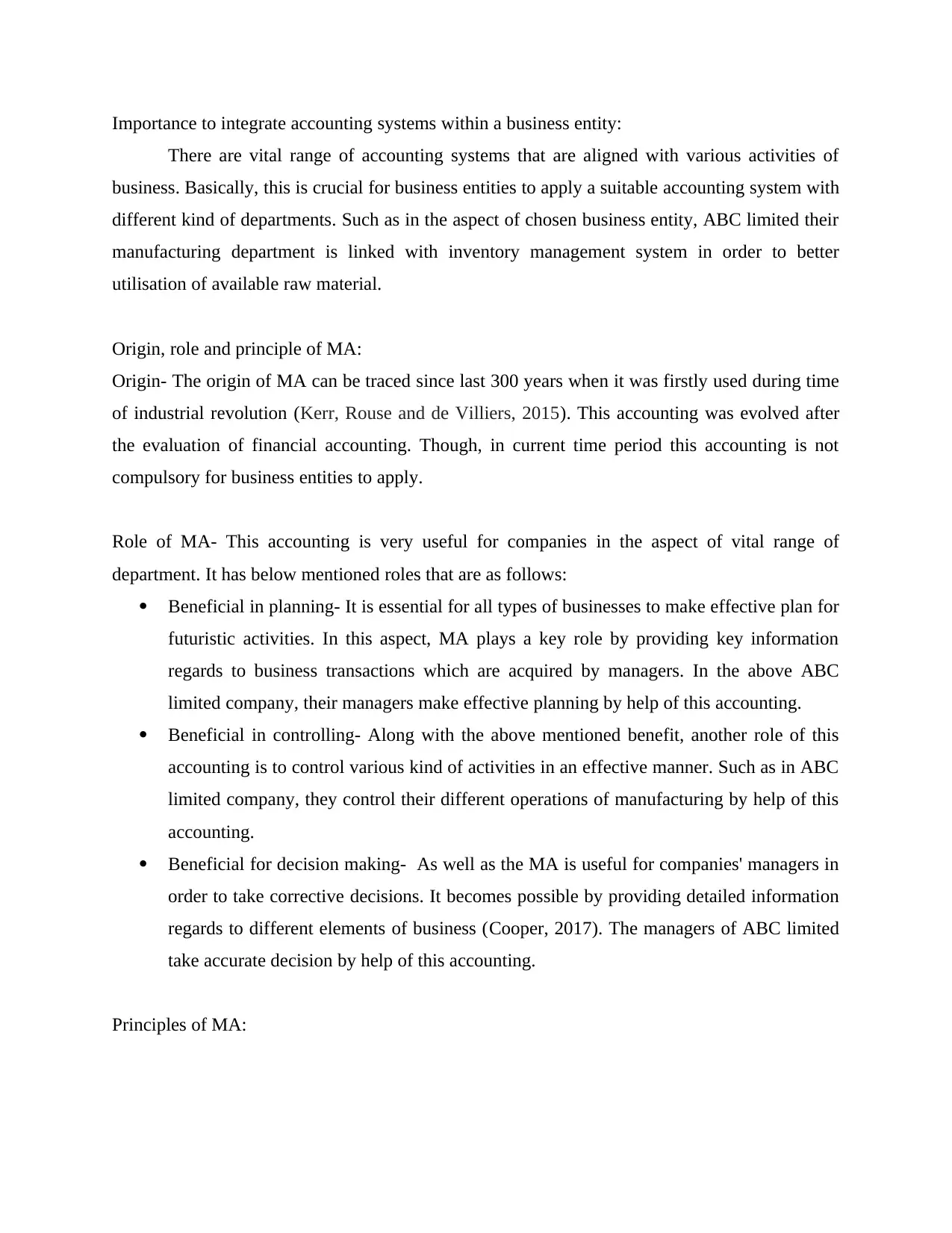
Importance to integrate accounting systems within a business entity:
There are vital range of accounting systems that are aligned with various activities of
business. Basically, this is crucial for business entities to apply a suitable accounting system with
different kind of departments. Such as in the aspect of chosen business entity, ABC limited their
manufacturing department is linked with inventory management system in order to better
utilisation of available raw material.
Origin, role and principle of MA:
Origin- The origin of MA can be traced since last 300 years when it was firstly used during time
of industrial revolution (Kerr, Rouse and de Villiers, 2015). This accounting was evolved after
the evaluation of financial accounting. Though, in current time period this accounting is not
compulsory for business entities to apply.
Role of MA- This accounting is very useful for companies in the aspect of vital range of
department. It has below mentioned roles that are as follows:
Beneficial in planning- It is essential for all types of businesses to make effective plan for
futuristic activities. In this aspect, MA plays a key role by providing key information
regards to business transactions which are acquired by managers. In the above ABC
limited company, their managers make effective planning by help of this accounting.
Beneficial in controlling- Along with the above mentioned benefit, another role of this
accounting is to control various kind of activities in an effective manner. Such as in ABC
limited company, they control their different operations of manufacturing by help of this
accounting.
Beneficial for decision making- As well as the MA is useful for companies' managers in
order to take corrective decisions. It becomes possible by providing detailed information
regards to different elements of business (Cooper, 2017). The managers of ABC limited
take accurate decision by help of this accounting.
Principles of MA:
There are vital range of accounting systems that are aligned with various activities of
business. Basically, this is crucial for business entities to apply a suitable accounting system with
different kind of departments. Such as in the aspect of chosen business entity, ABC limited their
manufacturing department is linked with inventory management system in order to better
utilisation of available raw material.
Origin, role and principle of MA:
Origin- The origin of MA can be traced since last 300 years when it was firstly used during time
of industrial revolution (Kerr, Rouse and de Villiers, 2015). This accounting was evolved after
the evaluation of financial accounting. Though, in current time period this accounting is not
compulsory for business entities to apply.
Role of MA- This accounting is very useful for companies in the aspect of vital range of
department. It has below mentioned roles that are as follows:
Beneficial in planning- It is essential for all types of businesses to make effective plan for
futuristic activities. In this aspect, MA plays a key role by providing key information
regards to business transactions which are acquired by managers. In the above ABC
limited company, their managers make effective planning by help of this accounting.
Beneficial in controlling- Along with the above mentioned benefit, another role of this
accounting is to control various kind of activities in an effective manner. Such as in ABC
limited company, they control their different operations of manufacturing by help of this
accounting.
Beneficial for decision making- As well as the MA is useful for companies' managers in
order to take corrective decisions. It becomes possible by providing detailed information
regards to different elements of business (Cooper, 2017). The managers of ABC limited
take accurate decision by help of this accounting.
Principles of MA:
Paraphrase This Document
Need a fresh take? Get an instant paraphrase of this document with our AI Paraphraser
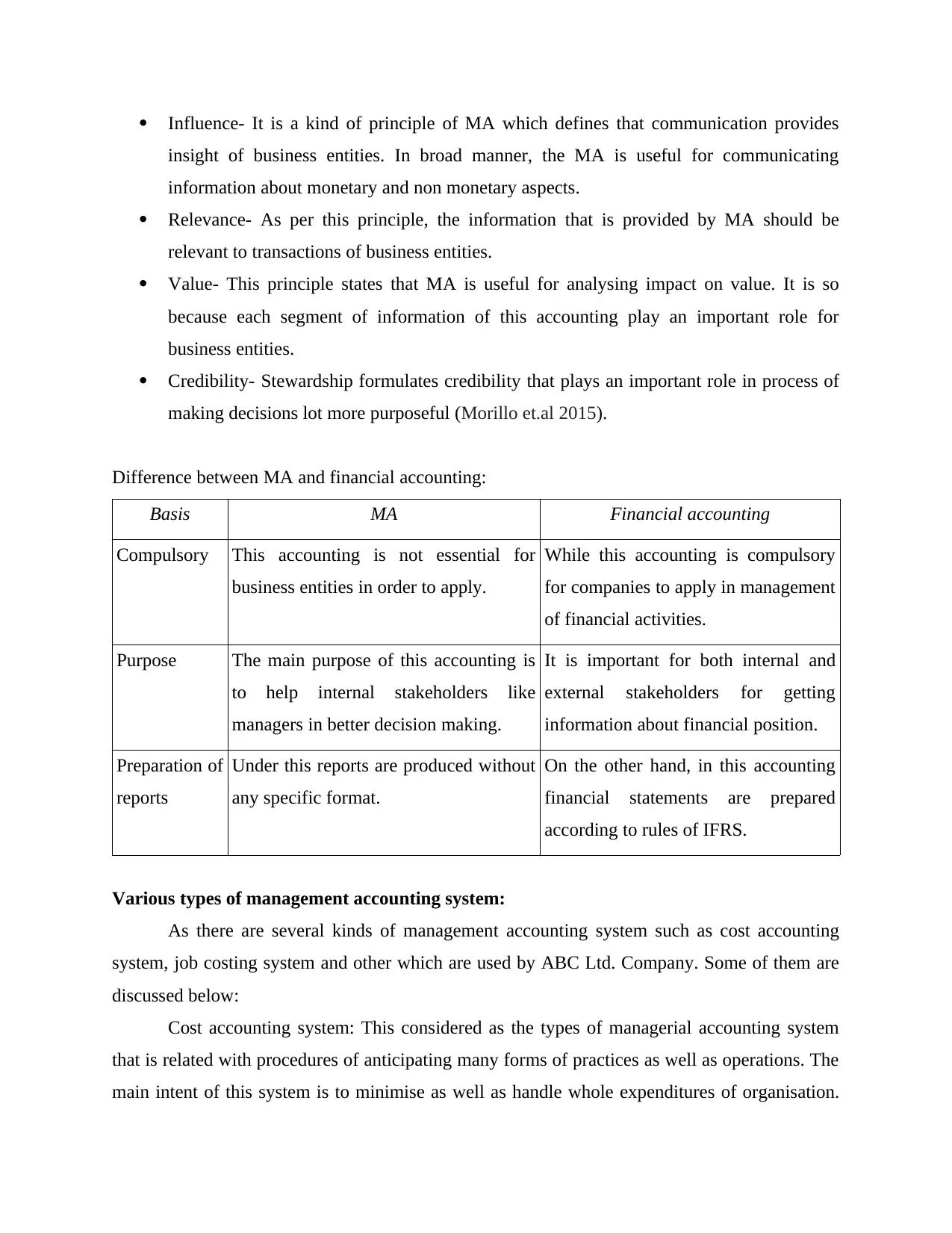
Influence- It is a kind of principle of MA which defines that communication provides
insight of business entities. In broad manner, the MA is useful for communicating
information about monetary and non monetary aspects.
Relevance- As per this principle, the information that is provided by MA should be
relevant to transactions of business entities.
Value- This principle states that MA is useful for analysing impact on value. It is so
because each segment of information of this accounting play an important role for
business entities.
Credibility- Stewardship formulates credibility that plays an important role in process of
making decisions lot more purposeful (Morillo et.al 2015).
Difference between MA and financial accounting:
Basis MA Financial accounting
Compulsory This accounting is not essential for
business entities in order to apply.
While this accounting is compulsory
for companies to apply in management
of financial activities.
Purpose The main purpose of this accounting is
to help internal stakeholders like
managers in better decision making.
It is important for both internal and
external stakeholders for getting
information about financial position.
Preparation of
reports
Under this reports are produced without
any specific format.
On the other hand, in this accounting
financial statements are prepared
according to rules of IFRS.
Various types of management accounting system:
As there are several kinds of management accounting system such as cost accounting
system, job costing system and other which are used by ABC Ltd. Company. Some of them are
discussed below:
Cost accounting system: This considered as the types of managerial accounting system
that is related with procedures of anticipating many forms of practices as well as operations. The
main intent of this system is to minimise as well as handle whole expenditures of organisation.
insight of business entities. In broad manner, the MA is useful for communicating
information about monetary and non monetary aspects.
Relevance- As per this principle, the information that is provided by MA should be
relevant to transactions of business entities.
Value- This principle states that MA is useful for analysing impact on value. It is so
because each segment of information of this accounting play an important role for
business entities.
Credibility- Stewardship formulates credibility that plays an important role in process of
making decisions lot more purposeful (Morillo et.al 2015).
Difference between MA and financial accounting:
Basis MA Financial accounting
Compulsory This accounting is not essential for
business entities in order to apply.
While this accounting is compulsory
for companies to apply in management
of financial activities.
Purpose The main purpose of this accounting is
to help internal stakeholders like
managers in better decision making.
It is important for both internal and
external stakeholders for getting
information about financial position.
Preparation of
reports
Under this reports are produced without
any specific format.
On the other hand, in this accounting
financial statements are prepared
according to rules of IFRS.
Various types of management accounting system:
As there are several kinds of management accounting system such as cost accounting
system, job costing system and other which are used by ABC Ltd. Company. Some of them are
discussed below:
Cost accounting system: This considered as the types of managerial accounting system
that is related with procedures of anticipating many forms of practices as well as operations. The
main intent of this system is to minimise as well as handle whole expenditures of organisation.
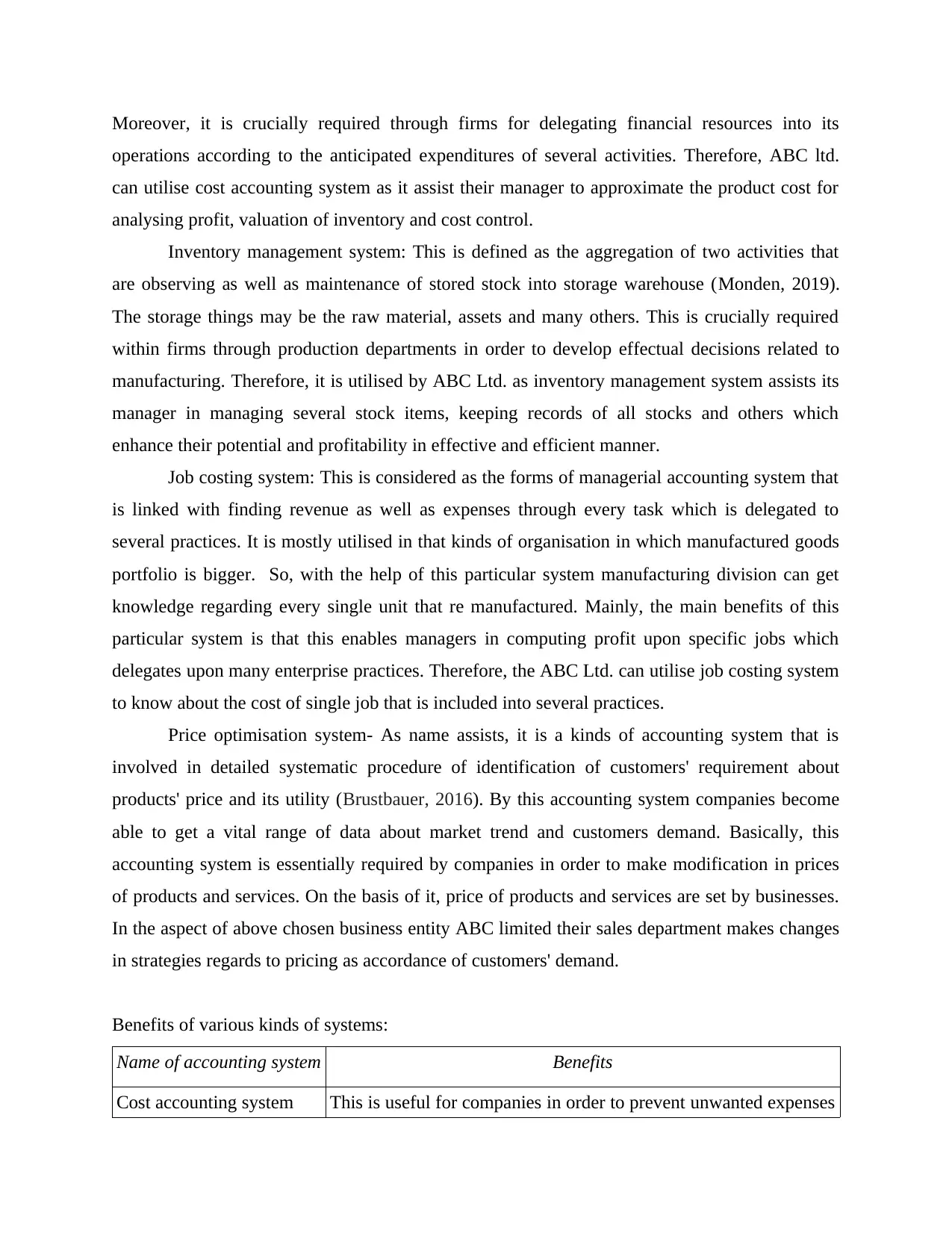
Moreover, it is crucially required through firms for delegating financial resources into its
operations according to the anticipated expenditures of several activities. Therefore, ABC ltd.
can utilise cost accounting system as it assist their manager to approximate the product cost for
analysing profit, valuation of inventory and cost control.
Inventory management system: This is defined as the aggregation of two activities that
are observing as well as maintenance of stored stock into storage warehouse (Monden, 2019).
The storage things may be the raw material, assets and many others. This is crucially required
within firms through production departments in order to develop effectual decisions related to
manufacturing. Therefore, it is utilised by ABC Ltd. as inventory management system assists its
manager in managing several stock items, keeping records of all stocks and others which
enhance their potential and profitability in effective and efficient manner.
Job costing system: This is considered as the forms of managerial accounting system that
is linked with finding revenue as well as expenses through every task which is delegated to
several practices. It is mostly utilised in that kinds of organisation in which manufactured goods
portfolio is bigger. So, with the help of this particular system manufacturing division can get
knowledge regarding every single unit that re manufactured. Mainly, the main benefits of this
particular system is that this enables managers in computing profit upon specific jobs which
delegates upon many enterprise practices. Therefore, the ABC Ltd. can utilise job costing system
to know about the cost of single job that is included into several practices.
Price optimisation system- As name assists, it is a kinds of accounting system that is
involved in detailed systematic procedure of identification of customers' requirement about
products' price and its utility (Brustbauer, 2016). By this accounting system companies become
able to get a vital range of data about market trend and customers demand. Basically, this
accounting system is essentially required by companies in order to make modification in prices
of products and services. On the basis of it, price of products and services are set by businesses.
In the aspect of above chosen business entity ABC limited their sales department makes changes
in strategies regards to pricing as accordance of customers' demand.
Benefits of various kinds of systems:
Name of accounting system Benefits
Cost accounting system This is useful for companies in order to prevent unwanted expenses
operations according to the anticipated expenditures of several activities. Therefore, ABC ltd.
can utilise cost accounting system as it assist their manager to approximate the product cost for
analysing profit, valuation of inventory and cost control.
Inventory management system: This is defined as the aggregation of two activities that
are observing as well as maintenance of stored stock into storage warehouse (Monden, 2019).
The storage things may be the raw material, assets and many others. This is crucially required
within firms through production departments in order to develop effectual decisions related to
manufacturing. Therefore, it is utilised by ABC Ltd. as inventory management system assists its
manager in managing several stock items, keeping records of all stocks and others which
enhance their potential and profitability in effective and efficient manner.
Job costing system: This is considered as the forms of managerial accounting system that
is linked with finding revenue as well as expenses through every task which is delegated to
several practices. It is mostly utilised in that kinds of organisation in which manufactured goods
portfolio is bigger. So, with the help of this particular system manufacturing division can get
knowledge regarding every single unit that re manufactured. Mainly, the main benefits of this
particular system is that this enables managers in computing profit upon specific jobs which
delegates upon many enterprise practices. Therefore, the ABC Ltd. can utilise job costing system
to know about the cost of single job that is included into several practices.
Price optimisation system- As name assists, it is a kinds of accounting system that is
involved in detailed systematic procedure of identification of customers' requirement about
products' price and its utility (Brustbauer, 2016). By this accounting system companies become
able to get a vital range of data about market trend and customers demand. Basically, this
accounting system is essentially required by companies in order to make modification in prices
of products and services. On the basis of it, price of products and services are set by businesses.
In the aspect of above chosen business entity ABC limited their sales department makes changes
in strategies regards to pricing as accordance of customers' demand.
Benefits of various kinds of systems:
Name of accounting system Benefits
Cost accounting system This is useful for companies in order to prevent unwanted expenses
⊘ This is a preview!⊘
Do you want full access?
Subscribe today to unlock all pages.

Trusted by 1+ million students worldwide
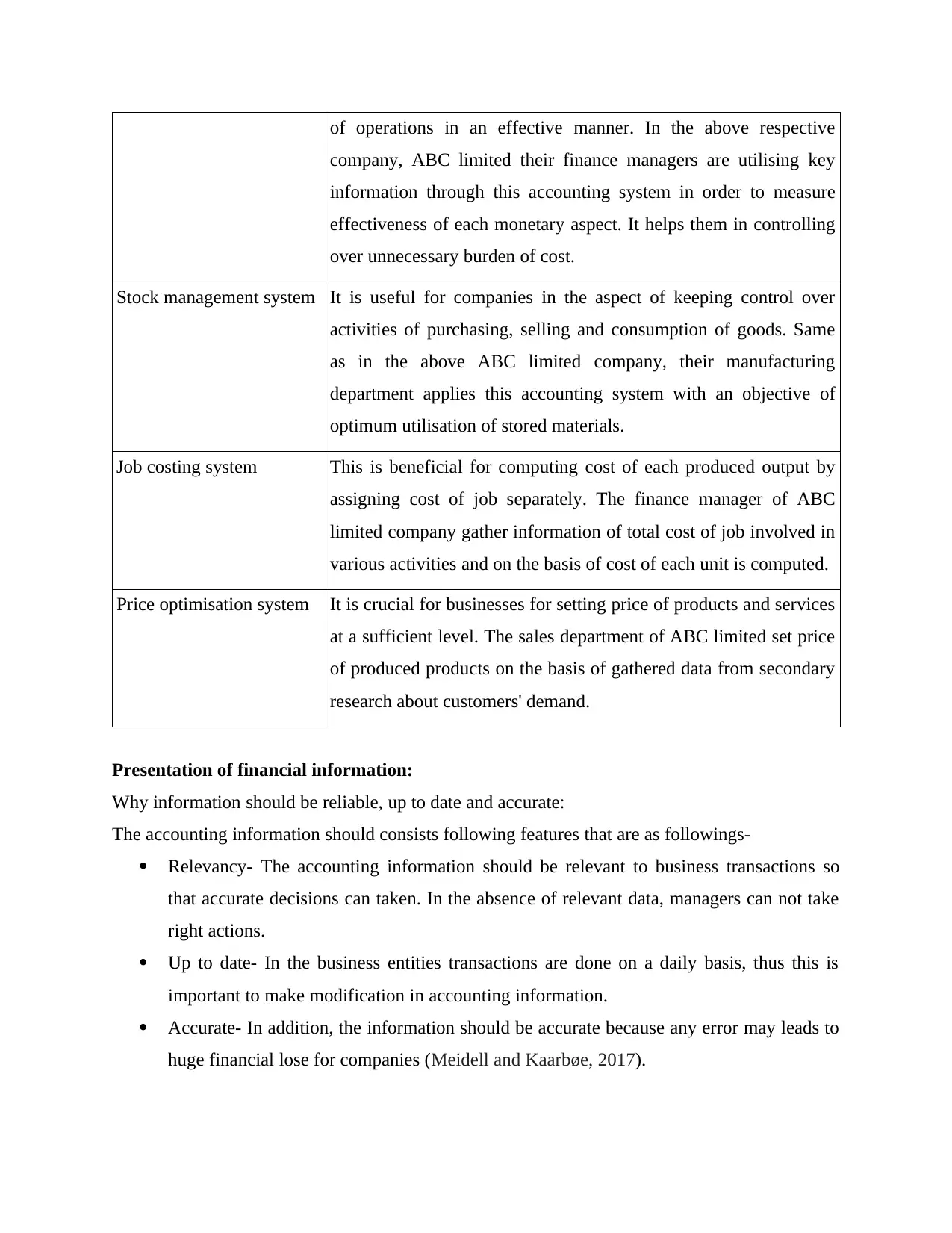
of operations in an effective manner. In the above respective
company, ABC limited their finance managers are utilising key
information through this accounting system in order to measure
effectiveness of each monetary aspect. It helps them in controlling
over unnecessary burden of cost.
Stock management system It is useful for companies in the aspect of keeping control over
activities of purchasing, selling and consumption of goods. Same
as in the above ABC limited company, their manufacturing
department applies this accounting system with an objective of
optimum utilisation of stored materials.
Job costing system This is beneficial for computing cost of each produced output by
assigning cost of job separately. The finance manager of ABC
limited company gather information of total cost of job involved in
various activities and on the basis of cost of each unit is computed.
Price optimisation system It is crucial for businesses for setting price of products and services
at a sufficient level. The sales department of ABC limited set price
of produced products on the basis of gathered data from secondary
research about customers' demand.
Presentation of financial information:
Why information should be reliable, up to date and accurate:
The accounting information should consists following features that are as followings-
Relevancy- The accounting information should be relevant to business transactions so
that accurate decisions can taken. In the absence of relevant data, managers can not take
right actions.
Up to date- In the business entities transactions are done on a daily basis, thus this is
important to make modification in accounting information.
Accurate- In addition, the information should be accurate because any error may leads to
huge financial lose for companies (Meidell and Kaarbøe, 2017).
company, ABC limited their finance managers are utilising key
information through this accounting system in order to measure
effectiveness of each monetary aspect. It helps them in controlling
over unnecessary burden of cost.
Stock management system It is useful for companies in the aspect of keeping control over
activities of purchasing, selling and consumption of goods. Same
as in the above ABC limited company, their manufacturing
department applies this accounting system with an objective of
optimum utilisation of stored materials.
Job costing system This is beneficial for computing cost of each produced output by
assigning cost of job separately. The finance manager of ABC
limited company gather information of total cost of job involved in
various activities and on the basis of cost of each unit is computed.
Price optimisation system It is crucial for businesses for setting price of products and services
at a sufficient level. The sales department of ABC limited set price
of produced products on the basis of gathered data from secondary
research about customers' demand.
Presentation of financial information:
Why information should be reliable, up to date and accurate:
The accounting information should consists following features that are as followings-
Relevancy- The accounting information should be relevant to business transactions so
that accurate decisions can taken. In the absence of relevant data, managers can not take
right actions.
Up to date- In the business entities transactions are done on a daily basis, thus this is
important to make modification in accounting information.
Accurate- In addition, the information should be accurate because any error may leads to
huge financial lose for companies (Meidell and Kaarbøe, 2017).
Paraphrase This Document
Need a fresh take? Get an instant paraphrase of this document with our AI Paraphraser
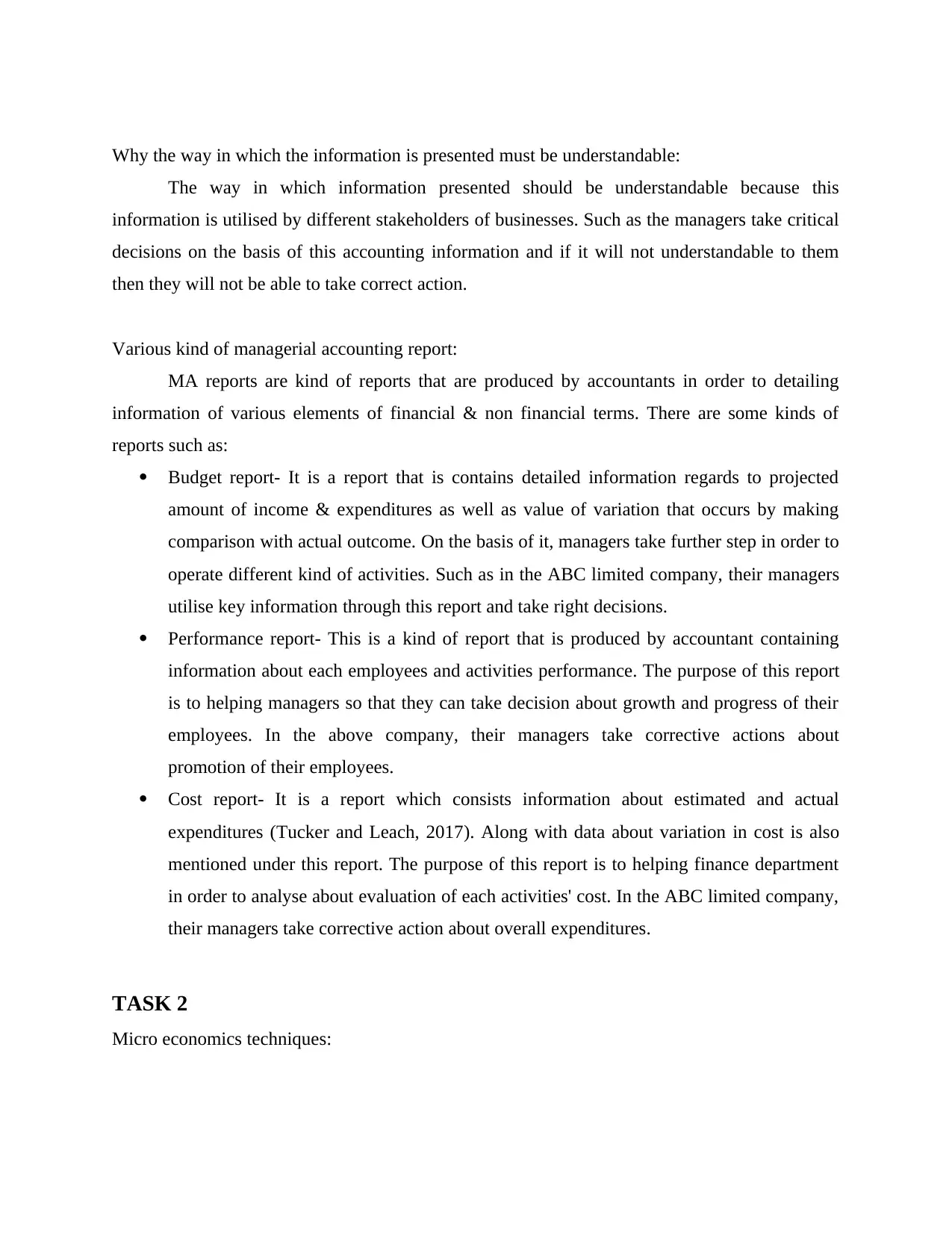
Why the way in which the information is presented must be understandable:
The way in which information presented should be understandable because this
information is utilised by different stakeholders of businesses. Such as the managers take critical
decisions on the basis of this accounting information and if it will not understandable to them
then they will not be able to take correct action.
Various kind of managerial accounting report:
MA reports are kind of reports that are produced by accountants in order to detailing
information of various elements of financial & non financial terms. There are some kinds of
reports such as:
Budget report- It is a report that is contains detailed information regards to projected
amount of income & expenditures as well as value of variation that occurs by making
comparison with actual outcome. On the basis of it, managers take further step in order to
operate different kind of activities. Such as in the ABC limited company, their managers
utilise key information through this report and take right decisions.
Performance report- This is a kind of report that is produced by accountant containing
information about each employees and activities performance. The purpose of this report
is to helping managers so that they can take decision about growth and progress of their
employees. In the above company, their managers take corrective actions about
promotion of their employees.
Cost report- It is a report which consists information about estimated and actual
expenditures (Tucker and Leach, 2017). Along with data about variation in cost is also
mentioned under this report. The purpose of this report is to helping finance department
in order to analyse about evaluation of each activities' cost. In the ABC limited company,
their managers take corrective action about overall expenditures.
TASK 2
Micro economics techniques:
The way in which information presented should be understandable because this
information is utilised by different stakeholders of businesses. Such as the managers take critical
decisions on the basis of this accounting information and if it will not understandable to them
then they will not be able to take correct action.
Various kind of managerial accounting report:
MA reports are kind of reports that are produced by accountants in order to detailing
information of various elements of financial & non financial terms. There are some kinds of
reports such as:
Budget report- It is a report that is contains detailed information regards to projected
amount of income & expenditures as well as value of variation that occurs by making
comparison with actual outcome. On the basis of it, managers take further step in order to
operate different kind of activities. Such as in the ABC limited company, their managers
utilise key information through this report and take right decisions.
Performance report- This is a kind of report that is produced by accountant containing
information about each employees and activities performance. The purpose of this report
is to helping managers so that they can take decision about growth and progress of their
employees. In the above company, their managers take corrective actions about
promotion of their employees.
Cost report- It is a report which consists information about estimated and actual
expenditures (Tucker and Leach, 2017). Along with data about variation in cost is also
mentioned under this report. The purpose of this report is to helping finance department
in order to analyse about evaluation of each activities' cost. In the ABC limited company,
their managers take corrective action about overall expenditures.
TASK 2
Micro economics techniques:
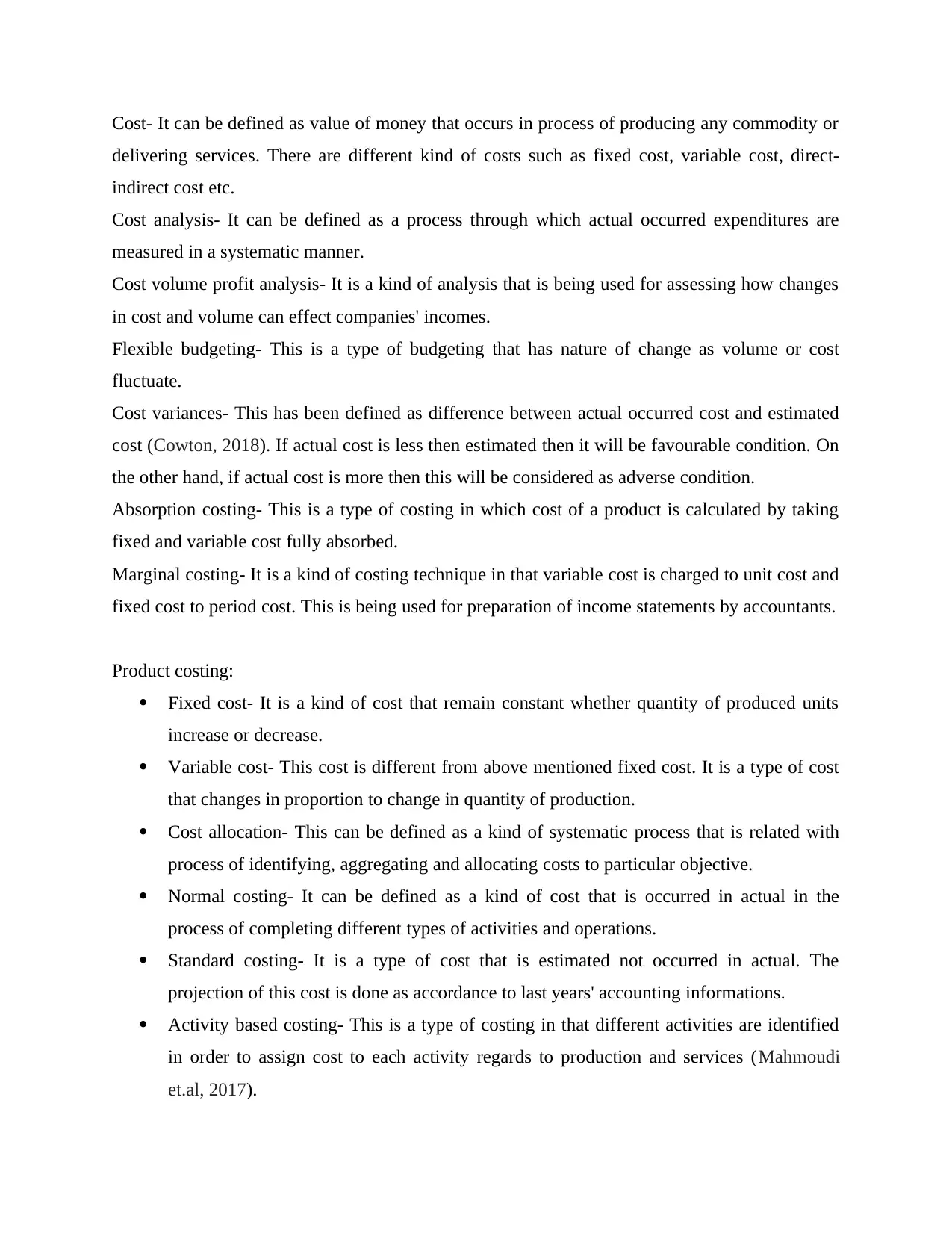
Cost- It can be defined as value of money that occurs in process of producing any commodity or
delivering services. There are different kind of costs such as fixed cost, variable cost, direct-
indirect cost etc.
Cost analysis- It can be defined as a process through which actual occurred expenditures are
measured in a systematic manner.
Cost volume profit analysis- It is a kind of analysis that is being used for assessing how changes
in cost and volume can effect companies' incomes.
Flexible budgeting- This is a type of budgeting that has nature of change as volume or cost
fluctuate.
Cost variances- This has been defined as difference between actual occurred cost and estimated
cost (Cowton, 2018). If actual cost is less then estimated then it will be favourable condition. On
the other hand, if actual cost is more then this will be considered as adverse condition.
Absorption costing- This is a type of costing in which cost of a product is calculated by taking
fixed and variable cost fully absorbed.
Marginal costing- It is a kind of costing technique in that variable cost is charged to unit cost and
fixed cost to period cost. This is being used for preparation of income statements by accountants.
Product costing:
Fixed cost- It is a kind of cost that remain constant whether quantity of produced units
increase or decrease.
Variable cost- This cost is different from above mentioned fixed cost. It is a type of cost
that changes in proportion to change in quantity of production.
Cost allocation- This can be defined as a kind of systematic process that is related with
process of identifying, aggregating and allocating costs to particular objective.
Normal costing- It can be defined as a kind of cost that is occurred in actual in the
process of completing different types of activities and operations.
Standard costing- It is a type of cost that is estimated not occurred in actual. The
projection of this cost is done as accordance to last years' accounting informations.
Activity based costing- This is a type of costing in that different activities are identified
in order to assign cost to each activity regards to production and services (Mahmoudi
et.al, 2017).
delivering services. There are different kind of costs such as fixed cost, variable cost, direct-
indirect cost etc.
Cost analysis- It can be defined as a process through which actual occurred expenditures are
measured in a systematic manner.
Cost volume profit analysis- It is a kind of analysis that is being used for assessing how changes
in cost and volume can effect companies' incomes.
Flexible budgeting- This is a type of budgeting that has nature of change as volume or cost
fluctuate.
Cost variances- This has been defined as difference between actual occurred cost and estimated
cost (Cowton, 2018). If actual cost is less then estimated then it will be favourable condition. On
the other hand, if actual cost is more then this will be considered as adverse condition.
Absorption costing- This is a type of costing in which cost of a product is calculated by taking
fixed and variable cost fully absorbed.
Marginal costing- It is a kind of costing technique in that variable cost is charged to unit cost and
fixed cost to period cost. This is being used for preparation of income statements by accountants.
Product costing:
Fixed cost- It is a kind of cost that remain constant whether quantity of produced units
increase or decrease.
Variable cost- This cost is different from above mentioned fixed cost. It is a type of cost
that changes in proportion to change in quantity of production.
Cost allocation- This can be defined as a kind of systematic process that is related with
process of identifying, aggregating and allocating costs to particular objective.
Normal costing- It can be defined as a kind of cost that is occurred in actual in the
process of completing different types of activities and operations.
Standard costing- It is a type of cost that is estimated not occurred in actual. The
projection of this cost is done as accordance to last years' accounting informations.
Activity based costing- This is a type of costing in that different activities are identified
in order to assign cost to each activity regards to production and services (Mahmoudi
et.al, 2017).
⊘ This is a preview!⊘
Do you want full access?
Subscribe today to unlock all pages.

Trusted by 1+ million students worldwide
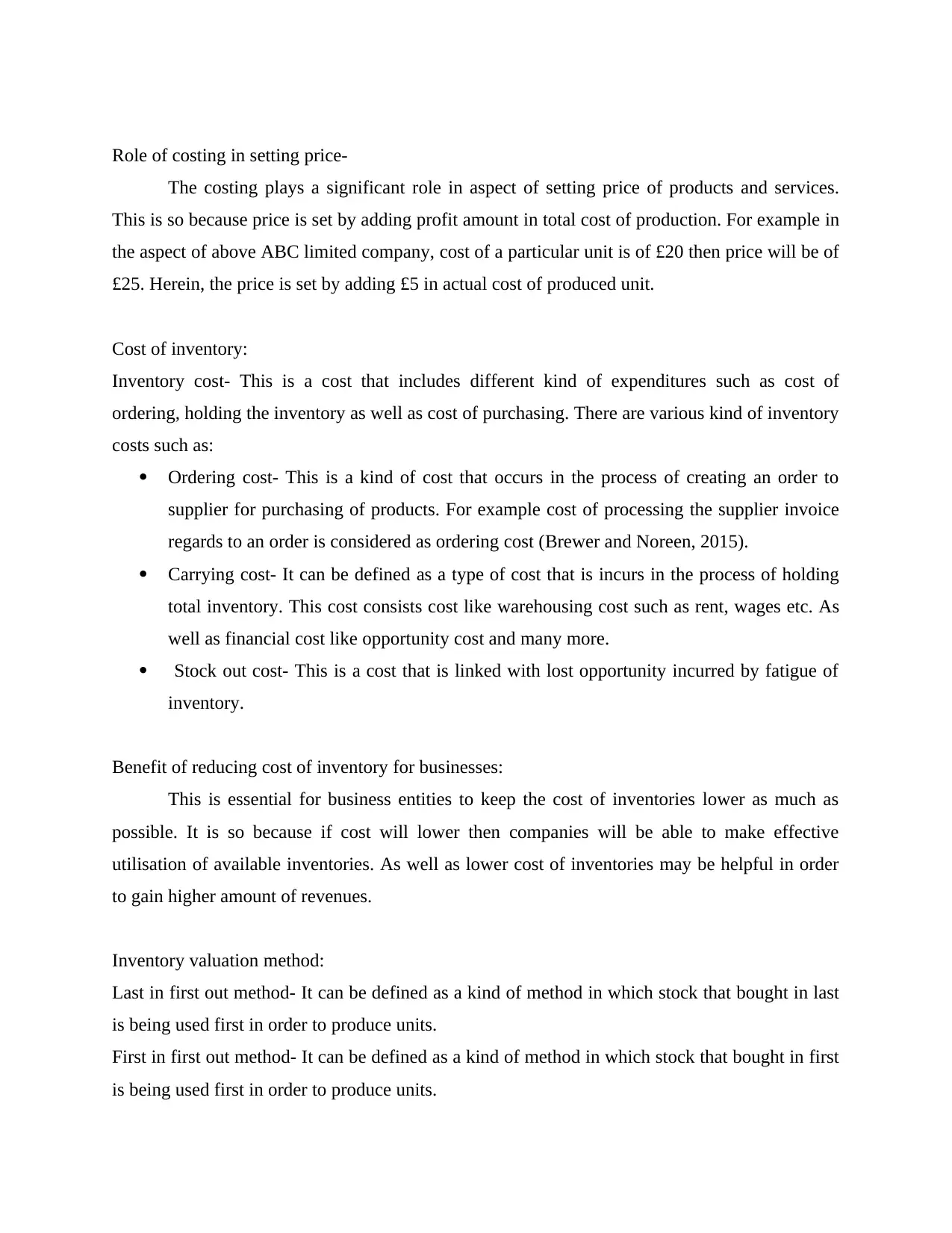
Role of costing in setting price-
The costing plays a significant role in aspect of setting price of products and services.
This is so because price is set by adding profit amount in total cost of production. For example in
the aspect of above ABC limited company, cost of a particular unit is of £20 then price will be of
£25. Herein, the price is set by adding £5 in actual cost of produced unit.
Cost of inventory:
Inventory cost- This is a cost that includes different kind of expenditures such as cost of
ordering, holding the inventory as well as cost of purchasing. There are various kind of inventory
costs such as:
Ordering cost- This is a kind of cost that occurs in the process of creating an order to
supplier for purchasing of products. For example cost of processing the supplier invoice
regards to an order is considered as ordering cost (Brewer and Noreen, 2015).
Carrying cost- It can be defined as a type of cost that is incurs in the process of holding
total inventory. This cost consists cost like warehousing cost such as rent, wages etc. As
well as financial cost like opportunity cost and many more.
Stock out cost- This is a cost that is linked with lost opportunity incurred by fatigue of
inventory.
Benefit of reducing cost of inventory for businesses:
This is essential for business entities to keep the cost of inventories lower as much as
possible. It is so because if cost will lower then companies will be able to make effective
utilisation of available inventories. As well as lower cost of inventories may be helpful in order
to gain higher amount of revenues.
Inventory valuation method:
Last in first out method- It can be defined as a kind of method in which stock that bought in last
is being used first in order to produce units.
First in first out method- It can be defined as a kind of method in which stock that bought in first
is being used first in order to produce units.
The costing plays a significant role in aspect of setting price of products and services.
This is so because price is set by adding profit amount in total cost of production. For example in
the aspect of above ABC limited company, cost of a particular unit is of £20 then price will be of
£25. Herein, the price is set by adding £5 in actual cost of produced unit.
Cost of inventory:
Inventory cost- This is a cost that includes different kind of expenditures such as cost of
ordering, holding the inventory as well as cost of purchasing. There are various kind of inventory
costs such as:
Ordering cost- This is a kind of cost that occurs in the process of creating an order to
supplier for purchasing of products. For example cost of processing the supplier invoice
regards to an order is considered as ordering cost (Brewer and Noreen, 2015).
Carrying cost- It can be defined as a type of cost that is incurs in the process of holding
total inventory. This cost consists cost like warehousing cost such as rent, wages etc. As
well as financial cost like opportunity cost and many more.
Stock out cost- This is a cost that is linked with lost opportunity incurred by fatigue of
inventory.
Benefit of reducing cost of inventory for businesses:
This is essential for business entities to keep the cost of inventories lower as much as
possible. It is so because if cost will lower then companies will be able to make effective
utilisation of available inventories. As well as lower cost of inventories may be helpful in order
to gain higher amount of revenues.
Inventory valuation method:
Last in first out method- It can be defined as a kind of method in which stock that bought in last
is being used first in order to produce units.
First in first out method- It can be defined as a kind of method in which stock that bought in first
is being used first in order to produce units.
Paraphrase This Document
Need a fresh take? Get an instant paraphrase of this document with our AI Paraphraser
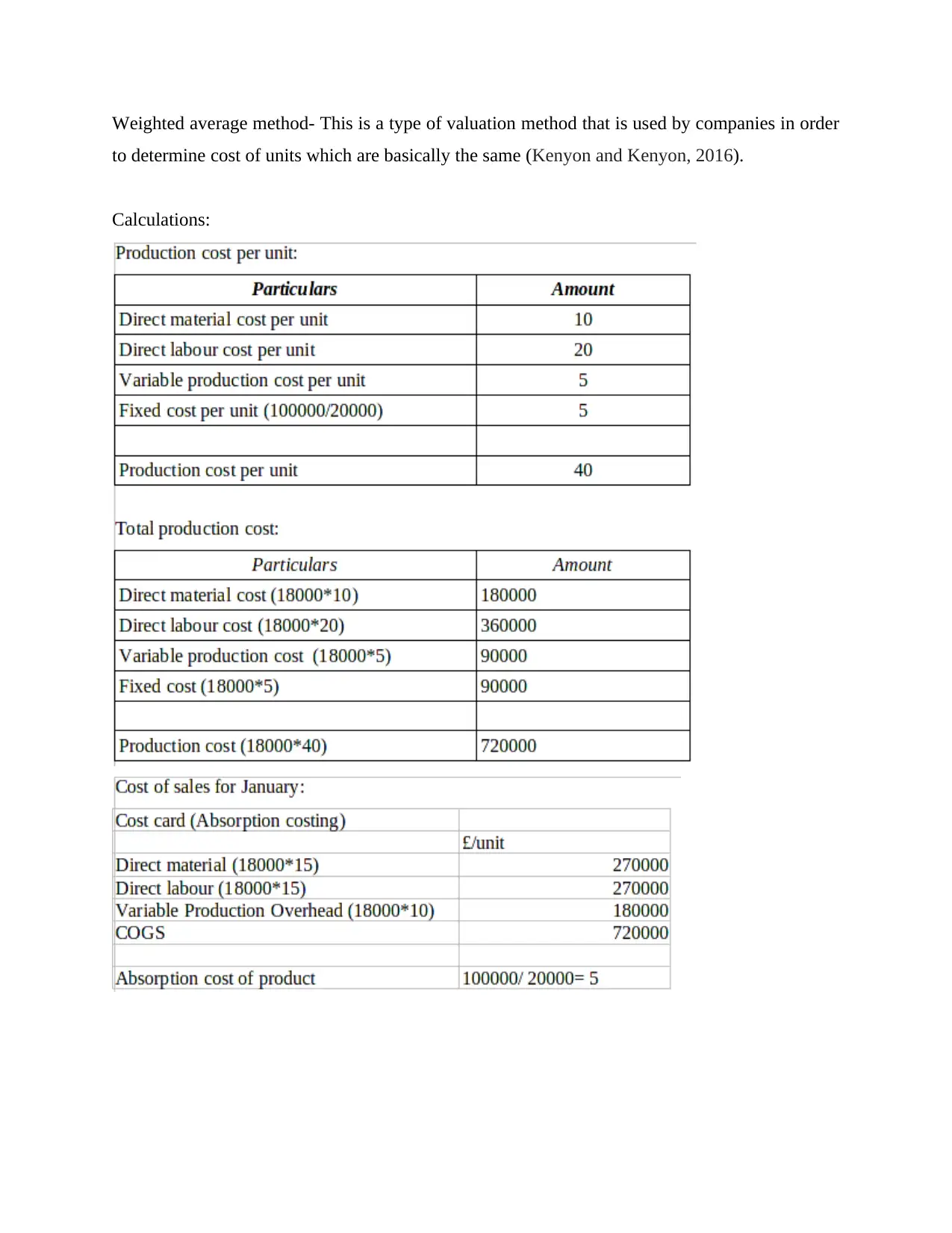
Weighted average method- This is a type of valuation method that is used by companies in order
to determine cost of units which are basically the same (Kenyon and Kenyon, 2016).
Calculations:
to determine cost of units which are basically the same (Kenyon and Kenyon, 2016).
Calculations:
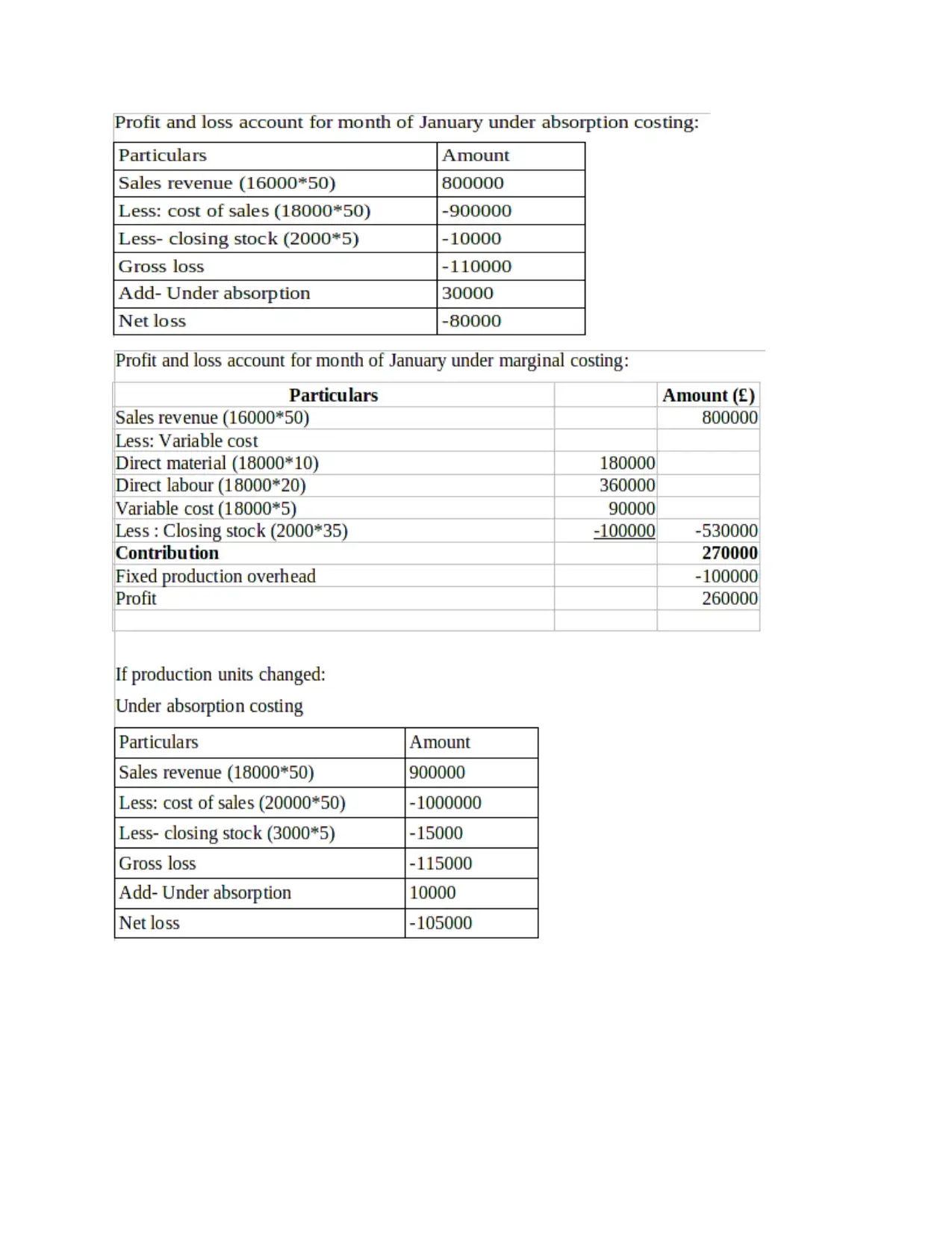
⊘ This is a preview!⊘
Do you want full access?
Subscribe today to unlock all pages.

Trusted by 1+ million students worldwide
1 out of 18
Related Documents
Your All-in-One AI-Powered Toolkit for Academic Success.
+13062052269
info@desklib.com
Available 24*7 on WhatsApp / Email
![[object Object]](/_next/static/media/star-bottom.7253800d.svg)
Unlock your academic potential
Copyright © 2020–2025 A2Z Services. All Rights Reserved. Developed and managed by ZUCOL.





